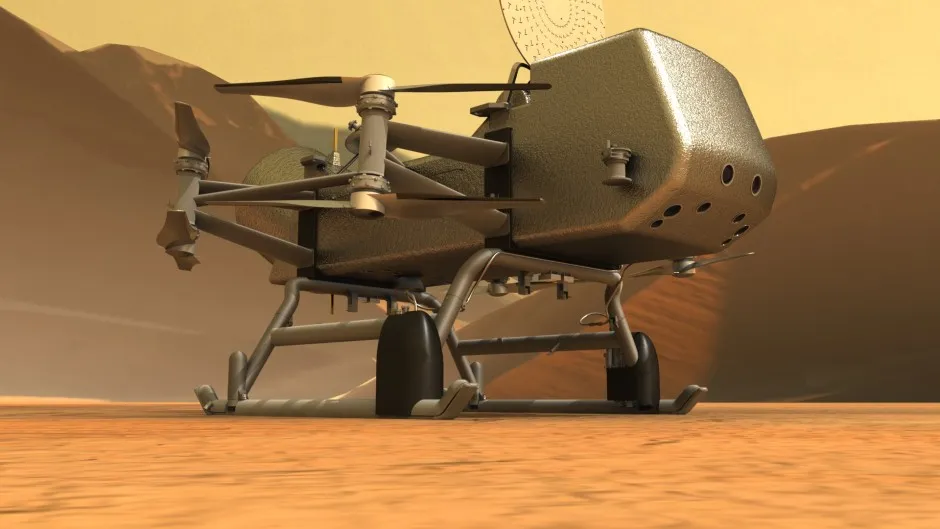Roughly 274,000,000km away, a hitchhiker is about to make extraterrestrial history. NASA’s Ingenuity Mars Helicopter is set to take flight on the Red Planet, the first time a flying vehicle has taken to the skies of another planet.
Ingenuity piggybacked to Mars on the Perseverance rover, which successfully landed in February. After deploying from the rover, it’s now waiting to stretch its long but lightweight wings and take a look around.
If it succeeds, Ingenuity will truly live up to its name. This is ambitious, experimental technology that has to clear a mind-boggling series of obstacles if it’s to rise from the rust-coloured dust of the Jezero Crater. No wonder observers are comparing it to the Wright Brothers’ first flight in 1903.
“It’s the first powered flight on another planet, another body outside of Earth,” says Prof Sanjeev Gupta, a geologist at Imperial College London and a strategic planner for the Perseverance mission.
Read more about the Perseverance mission:
- Perseverance is sending back weather reports from Mars
- Watch NASA's Perseverance rover land on Mars
- 11 history-making moments from the Perseverance mission
As well as designing a craft that can fly in the low gravity and low atmospheric pressure on Mars – all without the kind of navigational aids we have here on Earth – there’s also the fact that Ingenuity is an awfully long way from home.
“It’s being done totally autonomously because obviously there’s a time delay from Mars,” says Gupta. “In rover operations, what we do is we plan the next day of activities. The controllers don’t actually control them, they write computer commands based on code that’s already in Ingenuity. And it works kind of like a smartphone. We uplink parameters to make things happen.”
As a geologist, Gupta says he would love to be using Ingenuity to carry out science, but it’s primarily a technology demonstrator. Drones could revolutionise space exploration in much the same way that they have changed industries here on Earth, from search and rescue to delivery systems.
“I use drones all the time,” Gupta says. “That’s only really happened on Earth in the last few years when they’ve become light enough and small enough. As a geologists, you’re looking at rock formations, studying the landscape but we’re stuck on the ground. Drones can take images, survey things on a larger scale, scout ahead and get images of places we can’t get to on the ground.”
Their impact could be even greater on another planet where every movement for a robotic rover is perilous. “With a rover, we’re very limited with where we can go. If there’s a small hill in the way we can’t see over them. A drone would let us see over that hill and scout the terrain that is otherwise masked by other topography. It’s game-changing to remove some of those limitations and make exploration much more efficient.”

NASA already has a much bigger drone in the works. The Dragonfly spacecraft is plotting a course to Titan, the largest moon of Saturn, in 2027. It won’t get there until 2036 but when it does, the rotorcraft will fly from spot to spot looking for signs of alien life in one of the places best-suited to supporting it in the Solar System.
“The first science we do on other planets is always going to be geology, looking at rock formations, looking for evidence of life, so ensuring this technology works is a massive boost,” says Gupta.
Dragonfly is heading for an equatorial region of Titan known as Shangri-La, where it will land on mysterious dunes before investigating ground conditions that astrobiologists believe are similar to the primordial soup in which microbial life first developed on Earth. Equipped with eight rotor blades, it will then fly to dozens of locations covering a distance that is almost double what all the Mars rovers to date have managed.
Like Ingenuity, it will also be tailor-made to suit the conditions at its destination – only Titan should offer better flying conditions than Mars. It has low gravity, little wind and a dense atmosphere, all of which mean it's much more efficient to fly a heavier crafter than Ingenuity using basic rotor propulsion.
Many other flying drones are expected to follow, but first Ingenuity has to prove that it can fly with the first test flight scheduled for 11 April. “It’s a tiny helicopter,” Gupta says. “It’s only going to fly a few metres for a few seconds, but the impact is huge.”
One small flight, one giant leap.
Five minutes with the Perseverance team
Tim Canham, the Mars Helicoper Operations Lead at NASA, tells us how his team got a helicopter to Mars, and what it means for our future in the Solar System.
How big a deal was it simply to get Ingenuity there safely and deploy it from the rover?
It was a very big deal! We had to design the helicopter to fit on the rover and interface with the mechanical system that would deploy us to the surface. The process of deploying was a set of irreversible complex actions that took several days.
In addition, on the day of the drop we had to orchestrate a complicated live coverage final drop to the surface to make sure both the Perseverance Rover and Ingenuity Helicopter were safe. Finally, we had to coordinate communication with the helicopter to make sure it went to sleep safely for the cold Martian night.
What is the most challenging aspect of remote-piloting a helicopter from another planet?
The helicopter flights are very challenging in two respects. First, the Martian environment itself is challenging. The air is very thin (one per cent of the density of Earth), and there are unpredictable winds that we can estimate but never know for sure. Second, since there is no real-time control of the helicopter by humans, we have to design it to fly autonomously based on commands designed ahead of time by our team and transferred to the helicopter via Perseverance.
Ingenuity has to be robust enough to follow its course in the presence of disturbances like wind gusts and land safely. Once we send the commands to the helicopter, we have to rely on it complete flights on its own.
What do you think will be the most important lessons from this mission that inform similar vehicles on future missions?
We will get a treasure trove of flight performance and engineering data from the mission that can inform future missions. We will also learn much about how to autonomously operate the vehicle in a hostile environment like Mars. We hope that Ingenuity will be like the Sojourner [a rover that landed on Mars in 1997] and will be a pioneer for future missions of this type.
